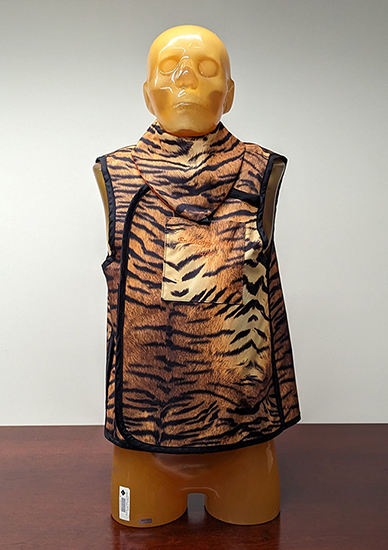All protective aprons should comply with Australian Standard AS/NZS IEC 61331.3:2022. State and territory regulators’ licence conditions may specify further requirements.
Introduction

For staff working in environments which have X-ray producing equipment, one of the main means of personal radiation protection is the protective apron.
Conventional protective aprons are primarily composed of lead (Pb) impregnated vinyl material. ARPANSA has received numerous inquiries on the testing of apron integrity and the performance of alternative light weight 'Lead Equivalent' materials.
All protective aprons should comply with the Australian/New Zealand Standard AS/NZS IEC 61331.3:2022 "Protective devices against diagnostic medical X-radiation, Part 3: Protective clothing, eyewear and protective patient shields". State and territory regulators’ license conditions specify further requirements.
The standard states the required attenuation equivalent of light-duty protective aprons shall be not less than 0.25 mm Pb over their entire area. For heavy-duty protective aprons, not less than 0.35 mm Pb for the front section and not less than 0.25 mm Pb for remaining parts.
Please note the reference to light-duty and heavy-duty aprons in the standard is for their usage and is not weight related. Light-duty aprons are recommended for operating theatres and heavy-duty in examination rooms.
Testing of aprons

Figure 1 – Inverse broad beam configuration[1]
Integrity testing
The International Commission on Radiological Protection (ICRP) recommends that protective garments be inspected with X-rays for integrity defects upon receipt and annually thereafter for any signs of deterioration[2].
Testing for imperfections in an apron can be achieved by fluoroscopy on a floating top table, or by radiography. Any cracks or holes found should be marked and recorded. To reduce costs, a protective apron may only require replacing if the sum of the defective areas is greater than 15 mm² in areas close to critical organs, and for areas at the back or along the seams, only if the sum of the defective areas is greater than 670 mm². Thyroid shields should be replaced if the sum of the defective areas is greater than 11 mm2.[3]
Lead equivalent testing
Measuring the 'lead equivalent' of a protective apron requires sophisticated equipment not normally available in a clinical environment. Figure 1 shows the inverse broad beam setup for measuring lead equivalent. This is the setup recommended by AS/NZS IEC 61331.1:2022 'Protective devices against medical X‑radiation, Part 1: Determination of attenuation properties of materials'.
The transmission through reference lead material is determined and plotted as a function of thickness. The transmission through the protective apron material is then measured and the 'lead equivalent' is determined from the reference lead transmission plot.
Light weight aprons
Although protective aprons are effective in reducing radiation exposure, they have the drawback of being heavy. Occupational health and safety considerations related to the wearing of these heavy garments need to be considered in tandem with the radiation protection requirements. Two-piece aprons consisting of a vest and skirt allow some of the weight to be supported at the hips to reduce strain on the back.
There are several manufacturers making aprons lighter in weight. These aprons are manufactured from composite materials such as tin, antimony, barium, lead, and bismuth. Manufacturers claim that large weight reductions are possible from traditional lead only aprons. However, these aprons tend to be less effective for tube voltages above 100 kV. Special consideration of the X-ray energy range the aprons will be used in is needed. AS/NZS IEC 61331.3:2022 requires the lead equivalent of an apron to be determined over a range of radiation qualities and for the range to be stated on the label.
Labelling requirements
For compliance with AS/NZS IEC 61331.3:2022, protective aprons should be labelled, as applicable, according to the following example:
XYZa Hb Pb 0,35c/50 – 100d 4,60e IEC 61331-3:2014f
- name of/trademark of manufacturer or supplier
- type of protective apron (e.g., H for heavy-duty protective apron)
- lead equivalent
- X-ray tube voltage range
- area density
- year of publication of the standard.
If different, the lead equivalent of both the back and front sections should be stated on the label.
Conclusion
All protective aprons should comply with Australian Standard AS/NZS IEC 61331.3:2022. State and territory regulators’ licence conditions may specify further requirements.
Both the design and 'lead equivalent' of an apron must be suitable for its intended use. Regular apron integrity testing for defects forms part of an X-ray department’s quality assurance program.
References
[1] IEC 61331-1 ed.2.0 Copyright © 2014 IEC Geneva, Switzerland. www.iec.ch Used with permission*
[2] ICRP Publication 139, Ann. ICRP 47(2), 1-118, (2018)
[3] Lambert K, McKeon T, Health Phys. 80(5 Suppl), S67-9, (2001)
*The author thanks the International Electrotechnical Commission (IEC) for permission to reproduce Information from its International Standards. All such extracts are copyright of IEC, Geneva, Switzerland. All rights reserved. Further information on the IEC is available from www.iec.ch. IEC has no responsibility for the placement and context in which the extracts and contents are reproduced by the author, nor is IEC in any way responsible for the other content or accuracy therein.


